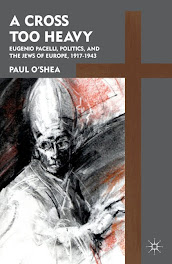Lux in Arcana is one
exhibition I would dearly love to see, but Australia Rome ’s Capitoline Museum
Reading the news
reports on the exhibition several things stand out.
Firstly, there is
the general level of ignorance in the mainstream media about the archives. They are not “secret” in the sense of hidden
or deliberately withheld. The Italian word
“segreto” can be translated to mean “private”, which is what in fact, they are. The ASV is the private or personal archive of
the pope. The terminology is
understandably confusing, but a simple question seeking clarification would
remedy the confusion, a point made by one of the exhibition organisers, archivist,
Pier Paolo Piergentili, author of TheVatican Secret Archives (2009).
Secondly, there
is the oft repeated assertion that the Vatican Florence
Thirdly, the
customary positions taken on Pius XII remain alive and kicking. The media, it seems, has little or no
interest in acknowledging the realms of gray about the war-time pope. The old chestnut of “wait until the archives
are opened and all shall be revealed” still attracts attention. No acknowledgement was made of the work that
has been done so far, or to at least recognise that the exhibition makes new
assertions regarding Pius XII.
Fortunately the
European Jewish Press has a more
nuanced approach. I have copied the
relevant section and made notes throughout the text.
The documents are part of an
unprecedented exhibition in Rome of rare Vatican
archives spanning centuries of history and include a report from a papal envoy
on the conditions inside seven internment camps in southern Italy
There are many documents found
in ADSS that record visits made by the Italian nuncio, Francesco Borgongini
Duca to internment camps throughout southern Italy Cosenza Italy
Another document is a letter
from a formerly interned rabbi in 1942 who thanks the then head of the Roman
Catholic Church for sending aid to the camp including clothes and linen.
Letters of thanks are found
throughout ADSS. They came from
individuals, families and communities across Europe, the UK (ADSS 9.346) and even Uruguay Zagreb ,
30.09.1942; ADSS 9.52 – Rabbi Alexander Safran, Bucharest ,
15.02.1943; ADSS 10.226 – the Jews of Rome, 10.06.1944, 10.288 – Jewish
families in Rome
A third document is from former
Jewish detainees who met with the pope for an audience in 1944 and expressed
their gratitude for his support.
They said the pope had sent
"substantial and generous gifts and demonstrated his keen and paternal
interest in our physicial, spiritual and moral wellbeing" and said he had
saved them from the threat of deportation to Poland
The Vatican
Bertone said the documents
were part of efforts for "historical truth", adding: "The
research on the period of Pius XII has so far generated more than two million
files and information about prisoners of war".
The head of the Vatican archives, Sergio Pagano, also said the full
archive from Pius XII would be made available "within one or two
years".
"The final decision
however depends on the pope," he told reporters.
Another document
included in the exhibition is a letter from the nuncio to the Netherlands Rome
While the
selection of documents is interesting, it breaks no new ground, but reinforces
what has been known from the available material that Pius XII was not inactive
in working to provide help where he could.
It is also imperative to remember that the Secretariat of State, the
nuncios and other Vatican diplomats acted in the pope’s name, so many of the
letters of thanks are expressed to the pope because people may not have known
who was directly responsible for getting the relief to the camps. Thanking the pope was a natural thing to do,
and Pius should be credited for this basic “work of mercy”. It is also important to recall that the most
work of this kind was done in Italy




No comments:
Post a Comment
You are welcome to post a comment. Please be respectful and address the issues, not the person. Comments are subject to moderation.